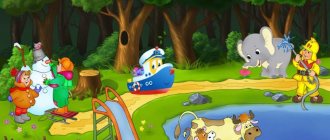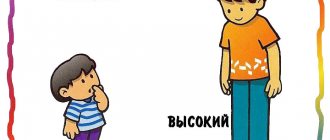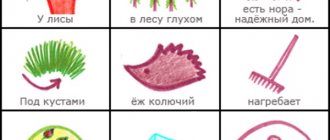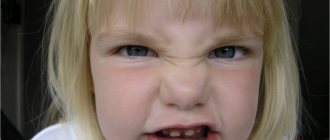Diagnosis of creative abilities of preschool children
Diagnostics allows you to assess a child’s inclinations in the creative field and identify the most promising areas for development.
Criteria for assessing artistic abilities according to the method of N. V. Shaidurova
N.V. Shaidurova developed a unique technique with which you can determine how artistically gifted a preschooler is and how developed he is. The essence of this technique is that a consultation is held, during which tasks are carried out with the arrangement of geometric figures, fine art and other things, with further evaluation using a point system. The number of points is determined by one of the three described levels (high, medium or low).
Creativity should be developed in children
How to identify a child's abilities
There are several practical methods for identifying the unique abilities and creative inclinations of children. The first two are more suitable for studying preschool children, the latter is relevant for working with schoolchildren.
- Analyzed observation. A simple method will reveal what the child shows true interest in, and what activities bring nothing but boredom. Advice: Most often, the child asks exactly what interests him the most. Be attentive to his questions, and you will be able to understand his range of interests.
- Game observation. During play, preschool children open up as much as possible. In a group game, it is easy to identify leadership qualities and the ability to communicate with other children. Watching a preschool child play with dolls or cars will allow you to understand how developed imagination and logic are.
- Tests, surveys. Such methods are used when it is difficult to identify the inclinations of school-age children or to reinforce previously obtained results. Parents can conduct tests or surveys themselves; it is better to consult a specialist about the results.
Development of creative abilities in preschool children: creativity
Creativity is a quality that will be useful to a child in adulthood, so its development needs to be given enough attention.
Experts offer several ways to develop creativity:
- Give your child free time. Constantly play with the baby and entertain him. Inventing games for him will not be beneficial for the development of his imagination.
- Refuse a large number of modern toys. These things do not allow the baby to fantasize. When the toy is simple, the child is forced to invent some elements or an unconventional way of using it.
- Less control. It is necessary to give the child room for imagination. Let him do what he likes without constant supervision.
- Develop talents. The family should help the child find something he likes. By visiting various clubs and looking for hobbies, you can interest your little one.
- Creative atmosphere. It is important for a child that he has his own children's room or creative corner, an area in which he is free to do whatever he wants. Let him assemble models from the construction set there, play outdoor games, the main thing is not to interfere with his creative impulses.
- Unbridled fantasy. It is useful to fantasize and make up different stories with your baby. You can watch a cartoon with him or read a fairy tale, and then fantasize about what he would do in the place of this or that hero. A theatrical family evening develops imagination well.
- Lead by example. It is useless to teach a child something if he does not see an example in the family. Parents need to engage in some kind of creativity themselves and create in the presence of the baby, raising their level.
Creativity is given special attention
The meaning and types of creative activity
The main significance of creative activity is that it contributes to the development of the baby’s speech.
Drawing “Icicles are crying” - spring theme for younger groups
Note! This is due to the fact that creativity stimulates the development of fine motor skills of the hands (the ability to make small and precise movements), and motor skills directly affect the speech center in the brain.
The main types of creativity are:
- artistic;
- scientific;
- technical
Some authors also highlight sports creativity, the purpose of which is to fulfill standards.
The purpose of artistic creativity is to create a work of art (song, painting, poem, etc.).
The goal of scientific creativity is to obtain new knowledge through discoveries, experiments, and research.
The goal of technical creativity is to create mechanisms.
Motor skills must develop
How to create conditions for the pedagogical process of developing creativity
The task of a teacher is to constantly develop and improve. While developing the creativity and imagination of his students, he should not forget about himself. The following will help create conditions for the pedagogical process of developing creativity:
- Constant self-development and “soul-searching”, evaluating oneself as an individual and a professional. It is worth improving visual, artistic, song taste.
- Creative activities with children.
- Attending open classes of other teachers, forums, seminars. It is important to update didactic material; you can write a course project, a research paper, improve your activities, and draw up a work plan.
The relationship between inclinations and abilities
A pronounced inclination to any calculations or measurements, the manifestation of logic in all matters, the desire to systematize data indicates a children’s predisposition to the exact sciences - mathematics, physics or chemistry.
A craving for musical works, constant purring of melodies, an excellent memory for musical works indicate musical abilities.
The child cannot be torn away from the book, he swallows whole volumes of fiction, reads works outside the curriculum, maybe even composes himself? This speaks of creative literary abilities.
Returning from kindergarten or school, the child not only tells, but also shows what happened during the day, imitates the behavior of loved ones, and takes part in creative amateur performances with pleasure. This is a born actor. You need to develop your theatrical skills.
Usually children cannot be kept away from drawing. But if your child spends almost all his free time with pencils or paints, loves to sculpt, and on all holidays you receive a gift created by his hands, the sphere of his creative abilities lies in the fine arts.
From preschool age, the child shows dexterity and dexterity, runs well, easily withstands the most serious loads, and should be considered a future brilliant athlete.
If you have a lot of construction toys in your home, and your child shows a great interest in complex mechanisms, he or she most likely has technical abilities.
Many friends, ease of communication not only with peers, but also with adults, the ability to establish contact even with strangers speak of communication skills. If your child feels like a duck to water among completely strangers and easily involves them in the game, social abilities are evident.
Development of creative thinking
You can enroll your child in a productive center for the development of children’s creativity, where specialist teachers will help develop the child’s creative thinking and imagination, but it is much more important to pay attention to the development of the child in the family.
Despite having a diploma, a teacher will not be able to achieve the desired result without the participation of parents.
Development of creative abilities of children in the family
Note! The main condition for the development of creative abilities in a child in the family is the parental example. If a parent believes and voices that all this is nonsense, a waste of time and it is better to do something serious and useful, then the child is unlikely to be happy to take up markers or start sculpting from plasticine.
You need to find something you like and devote at least a small amount of free time to it. In this case, even if the baby does not show any interest in creativity, sooner or later he will begin to wonder what his father, mother, older or younger brother is doing so enthusiastically, and then he himself will begin to get involved in the process.
Collaborative creativity develops better
Methods for developing the creative abilities of preschoolers
The methodology is a system of tools and teacher actions aimed at developing the child’s creative abilities.
Planning a walk in the preparatory group in the spring according to the Federal State Educational Standard
For your information! The main method for children of this age will, of course, be play. Its relevance will never go away. It is through play that children easily learn new knowledge and gain skills. For them, this technique is the most effective, exciting and productive.
There is also a group of techniques:
- verbal;
- practical;
- visual.
Development of associativity in the game
Exercises for children aimed at forming associations (the relationship between objects, events) have a positive effect on mental development, developing thinking and imagination.
Games according to the Federal State Educational Standard for the development of associativity are very simple, for example, you can select the object “dog” and, together with your child, name or write words that can be associated with the dog (collar, muzzle, leash, bone, tail, booth, barking, etc. ). Or select cards so that each has a pair, then mix them and give the child the opportunity to reunite the pairs (umbrella - rain, night - sleep, toothbrush - toothpaste, musical instrument - note, presentation - projector, drawing - brush, meeting – parents, instrument technician and others).
Development of systems thinking
Systemic thinking is what will free the child from memorizing a large amount of information, which most of the time is unclaimed. Developed systems thinking allows you to relate objects to each other, see the world as a set of parts that have relationships with each other, highlight these parts, allow you to generalize, draw conclusions and conclusions based on available facts. Special exercises help develop systems thinking.
For your information! It is important to teach a child to play in such a way that he can come up with many interesting things with one object. It is best to purchase multi-tasking toys with which you can create several games, for example, cups that stack on top of each other. They can be used by nesting them, stacking them on top of each other like a pyramid, playing with them in the sand, in the water, learning colors, counting, the concept of size, more, less, average and much more.
Parents must lead by example
Dialecticality of preschoolers
Dialecticality is a very interesting property, which consists in the fact that a person can detect inconsistencies, contradictions, and features. It is an integral part of critical thinking. It is effective to develop dialecticism with the help of the game “Pros and Cons”. The essence of this game is that the child is asked to highlight the positive and negative aspects of a character or event.
It is not so important if the child is not always able to achieve a certain result after creative activities. He will receive the main benefit in the process of creative activity.
Who and where will reveal the child’s abilities?
There are three places to identify a child’s abilities and inclinations - kindergarten, school and, of course, family. In this case, the main role falls on the family. Teachers of a preschool educational institution work within the framework of a specific program aimed at mass education and upbringing of children. There is little time left to determine individual qualities. And although the baby spends most of his time in kindergarten, the main role will belong to the parents.
At school, where a teenager receives a huge amount of knowledge, the same problem occurs. The focus of the traditional curriculum on mass learning leaves teachers very little opportunity for a strictly individual approach to everyone in the class.
The only place where a little person receives maximum attention is the family. It is the parents who bear the credit for the timely identification and subsequent development of a new member of society with a set of unique qualities and abilities.
Remarkable fact
The story of Thomas Edison is indisputable proof that only thanks to parents a child gets a chance to become an outstanding person.
As a little boy, Thomas returned from school with a letter from his teacher. The mother could not hold back her tears when she read the letter. She even read it to her son: “Your child is too brilliant for our school, so take care of his education yourself.”
Many years later, while sorting through the family archive, Thomas found a letter from a teacher to his mother. “Your son is mentally retarded. We cannot continue to teach him at school with other children. We strongly recommend that you educate him at home” - this is what was actually written in that message. When the truth was revealed, Thomas Edison was world famous as an inventor.
The correct approach to a child, determining his abilities is the main guarantee of the future successful life of a little person.
Keys to Developing Creativity
In order to purposefully develop creativity and grow creatively, the basic concepts are defined: the “keys” to launching. They are understood as factors that contribute to the emergence, development and further use of a child’s own potential.
- Knowledge.
- The ability to control the situation.
- Experience.
It is necessary to accumulate positive experiences of children who have learned to use creative thinking. It is important to share this experience with other students.
- Support for leaders.
Singling out children with pronounced abilities so as not to “over-praise” or belittle the efforts of others. Raising in successful children a willingness to share and experience in achieving success.
- Awards and promotions.
- The power of emotions.
Keeping your child in a good mood even when an attempt fails encourages “belief next time.”
- Broad outlook.
Reading, interviews, and discussion of what you read develop the ability to be creative.
- Independence, lack of an “anchor”.
Children who can easily switch from idea to idea find it easier to be flexible.
- Ability to play.
- Persistence.
- The ability to empathize.
Children who can hear others have the gift of “group” creativity. They are able to perceive the unrealized ideas of other children, add something of their own to them and present them as a joint solution.
- Developing self-respect.
- Inventiveness, open-mindedness.
- The ability to go beyond.
Creating combinations of ideas and solutions, combining ideas into groups according to direction stimulates the development of creativity.
- Introspection.
Summing up the results of a test, game or survey should encourage the child to develop further, and not “get hung up” on an unsuccessful result.
- Balance between feelings and thinking.
- Courage, self-confidence.
- Ability to take risks.
It is necessary to explain to the child that not all, even the most daring creative decisions are doomed to success. The willingness to take risks and fail should encourage further improvement of the idea.
- Understanding and prioritizing creativity.
Thinking creatively more often than is usually possible is the motto of every day.
- Responsibility.
This is a potential that will not allow you to pass off other people’s ideas as your own. At the same time, responsibility must be different from routine. It should not interfere with the implementation of creative ideas.
- Discipline.






